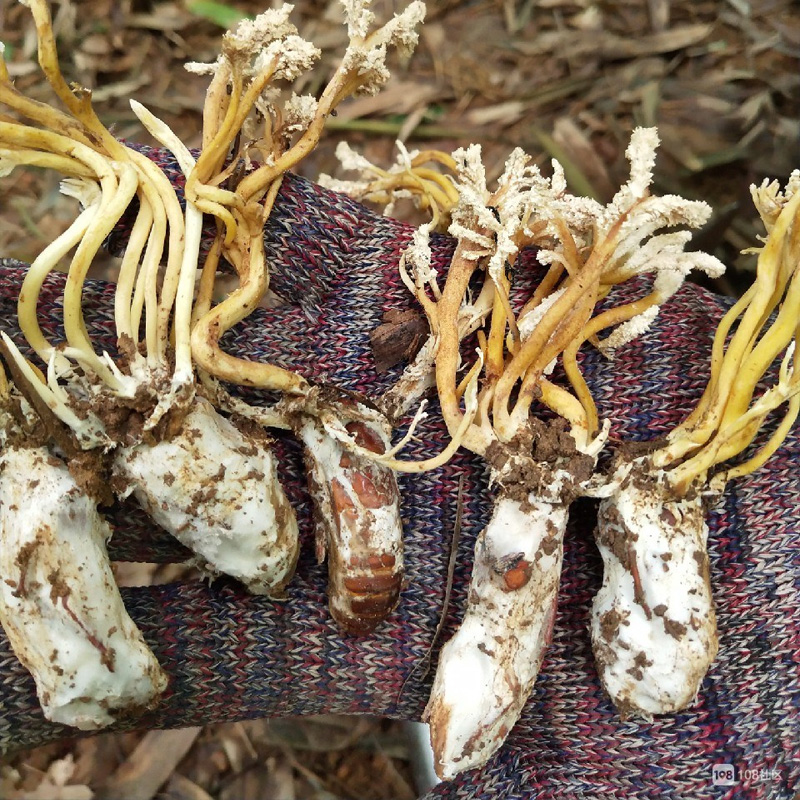CICADA PUPAE FLOWER

CICADA PUPAE FLOWER
Cicada pupa flower, also known as cicada flower, cicada cicada, cicada antler, crown cicada, cicada, etc., its scientific name is "cicada pseudomonas", which is a complex of insects and bacteria formed by the parasitic fungus cicada pseudomonas on the nymphs (mainly cicada pupae or larvae) of a certain cicada. This complex contains both the larvae of cicadas and the cicada fungus that grows on them, thus possessing unique medicinal value.
1、 Basic attributes
Species: phylum Fungi, subphylum Ascomycota, order Botrytis, family Botrytis, genus Cordyceps.
Growth mode: Cicada fungus parasitizes on cicada nymphs and grows after absorbing their nutrients.
Appearance features: The sub seat is single or 2-3 bundled from the front end of the main body, measuring 2.5-6cm in length, hollow, with a cinnamon colored handle and a rod-shaped head that changes color after drying.
2、 Distribution area
Cicada pupae are mainly distributed in Jiangsu, Zhejiang, Fujian, Sichuan, Yunnan, Gansu and other places in China, especially in bamboo forests and other environments. But due to its harsh growth conditions and relatively low yield, it is more precious.
3、 Medicinal value
Cicada pupae have rich medicinal ingredients, such as protein, polysaccharides, amino acids, as well as trace elements such as copper, manganese, and zinc, which make them widely applicable in the field of traditional Chinese medicine. Its main functions include:
Enhancing the body's immunity: Cicada pupae can increase the content of albumin and total serum protein in the body, thereby enhancing the immune system function and achieving the effect of strengthening the body and prolonging life.
Anti fatigue: Cicada pupae have the ability to promote metabolism in the body, accelerate the elimination of toxins and metabolic waste, and alleviate fatigue.
Tonifying the liver and benefiting the kidneys: Cicada pupae can enter the liver and kidney meridians, and have a certain therapeutic effect on symptoms such as soreness and weakness of the waist and knees, lack of qi and laziness, dizziness, tinnitus, impotence, premature ejaculation, etc. caused by liver and kidney deficiency.
Antitumor: In clinical practice, cicada pupae are used for anti-tumor treatment, especially for fever caused by the central nervous system, which has significant therapeutic effects.
Other benefits: Cicada pupa flowers also have various effects such as antipyretic and analgesic, improving kidney function, promoting the improvement of hematopoietic system function, nourishing and strengthening. In addition, it also has anti radiation, anti-tumor, and blood sugar lowering effects.
4、 Eating method
There are various ways to consume cicada pupa flowers, including the following common ones:
Stewed soup: Take two or three cicada pupae and wash them, place them in a stew pot, add red dates and other ingredients to stew together, and then eat.
Powder administration: Grind cicada pupae into powder and fill it into capsules, then swallow with water.
Tonic Diet mixing: add cicada pupa flower into dishes to make Tonic Diet for eating.
Steaming and cooking for consumption: Soak the cicada pupae in cold water until soft, remove the outer coat and hard shell, retain the insect body and mycelium, and wash them before steaming and cooking for consumption.
5、 Precautions
Although cicada pupa flowers have various medicinal values, not everyone is suitable for consumption. It is best to consult a doctor or professional before consumption.
The collection and consumption of cicada pupae flowers should comply with relevant laws, regulations, and provisions to ensure that the source is legal and safe.
During the consumption process, attention should be paid to moderate consumption to avoid excessive intake that may cause discomfort to the body.
Cicada pupa flower, as a precious traditional Chinese medicine, has various medicinal values and edible methods. Under the premise of correct use and consumption, it can exert its maximum efficacy and effect.




